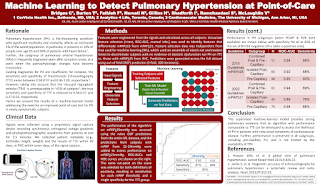Washington DC—November 12, 2023—CorVista Health, Inc, a leading digital health company dedicated to improving cardiovascular disease diagnosis, is pleased to announce the presentation of Machine Learning to Detect Pulmonary Hypertension data at AHA.
“We are pleased to present this important data at this year’s AHA meeting.” said Don Crawford, President and CEO of CorVista Health. “Pulmonary hypertension is a challenging condition to diagnose, especially early in the disease progression. This presentation follows the FDA’s Breakthrough Designation for the CorVista System Add-On to detect pulmonary hypertension and the recent FDA clearance of the coronary artery disease platform.”
Pulmonary hypertension (PH), a life-threatening condition with significant morbidity and mortality, affects an estimated 1% of the world population. It is present in 10% of people over age 65 and 50% of patients with heart failure. Further, the subgroup of pulmonary arterial hypertension (PAH) is frequently diagnosed years after symptom onset, at a point when the pathophysiologic changes have become irreversible.
Existing diagnostics for PH are insufficient; for instance, the sensitivity and specificity of Transthoracic Echocardiography (TTE) varies over a wide range. Moreover, TTE requires specialized equipment and technical support that is often unavailable. Herein we present the results of a machine-learned model addressing the need for an improved point-of-care test for PH in newly symptomatic subjects.
The presentation demonstrates the ability to develop a point of care method to detect PH, based on cardiac orthogonal voltage gradient (OVG) signals and photoplethysmographic (PPG) signals. A machine learned (ML) algorithm was developed to discriminate subjects with no evidence of diastolic dysfunction nor PH on TTE vs. those with mPAP≥25 mmHg from right heart catheterization.
The AUC of the algorithm was 0.93, the sensitivity 87%, and the specificity 83%. Further, the performance is preserved in all subgroups, including pre-capillary PH. This supervised machine-learned model therefore provides strong preliminary evidence that an algorithm can be developed to assess the likelihood of PH in patients with new onset symptoms of cardiovascular disease... CorVista Health's Press Release -

